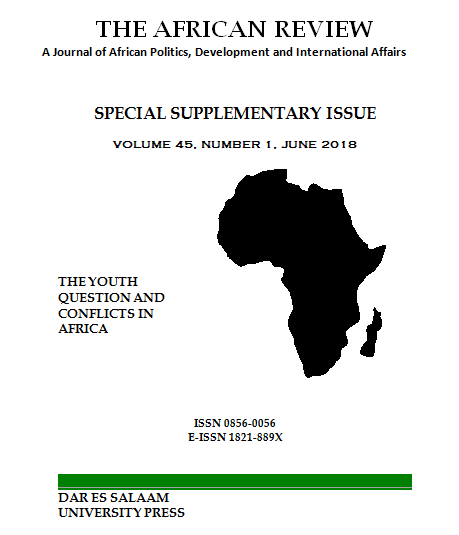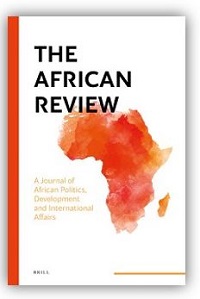Youth Gangsters and Girlfriending: Intimate Relations in the Townships
Abstract
This research adds to the scholarly argument that "work is still needed to provide a more complex picture of young women's involvement in gangs" (Sutton, 2017: 150). Focusing on Gugulethu (a black township in Cape Town, South Africa), this paper discusses selected aspects of intimate relations between female youth and men involved in gangsterism. It goes beyond describing these women as simple victims of these male gangsters ' ego by paying attention to cases where these "girls" are in control of their men. The conclusion suggests that masculinity expected in gangsterism and the South African township culture are among the outstanding causes behind the manipulations, abuses, and other forms of gender-based violence that women inflict upon their gangster men and which remain overlooked in research as well as in the community. The research found that there are cases where the gangsters ' girlfriends are not just the most benefitting socio-economically from the unlawful activities their men get involved in, but they are also the masterminds behind their men ' s crimes which are often accompanied with violence and arrests. The paper draws on the ethnographic approach in the townships, observations, life stories, in-depth interviews and follow-up interviews in Gugulethu.
Keywords: Gugulethu, Gangsters, Gender Violence, Youth, Perpetrators
Rosette S. Vuninga, PhD fellow, University of Western Cape, E-mail: rosettesifa@gmail.com
References
Abrahams, N., R. Jewkes, R. Laubscher, and M. Hoffman 2006. "Intimate partner violence: prevalence and risk factors for men in Cape Town, South Africa", Violence and victims, 21 (2): 247-64.
Barber, F. C. 2008. "Domestic violence against men", Nursing Standard (through 2013), 22(51):35-9.
Bhana, D. and R. Pattman 2011. "Girls want money, boys want virgins: The materiality of love amongst South African township youth in the context of HIV and AIDS", Culture, health & sexuality, 13 (8):961-972.
Carlson, B. E. 1997. "A stress and coping approach to intervention with abused women", Family Relations, 46 (3):291-298.
Cilliers, J. and C. Aucoin, 2016. "Economics, governance and instability in South Africa" Institute for Security Studies Papers, 2016(293):1-24.
Firmin, C. 2013. "Love hurts: Cheating and violence in teenage women's talk of boyfriends", Agenda, 27(2):47-55.
Glaser, C. 1990. The mark of Zorro: sexuality and gender relations in the Tsotsi subculture on the Witwatersrand, 1940 - 1960 . Working Paper: University of Witwatersrand.
Grunebaum-Ralph, H. 2001. "Re-placing pasts, forgetting presents: narrative, place, and memory in the time of the Truth and Reconciliation Commission", Research in African Literatures, 32(3):198-212.
Hurst, E. 2009. "Tsotsitaal, global culture and local style: identity and recontextualisation in twenty-first century South African townships", Social Dynamics, 35 (2):244-257.
Jewkes, R., J. Levin, and L. Penn-Kekana 2002. Risk factors for domestic violence: findings from a South African cross-sectional study", Social science & medicine, 55 (9):1603-1617.
Jewkes, R., R. Morrell, and N.Christofides 2000. "Empowering teenagers to prevent pregnancy: lessons from South Africa", Culture, health and sexuality, 11(7):675688.
Kalichman, S. C., and L. C. Simbayi 2003. "HIV testing attitudes, AIDS stigma, and voluntary HIV counselling and testing in a black township in Cape Town, South Africa", Sexually transmitted infections, 79(6):442-447.
Laidler, K. J. and G. Hunt, 2001. "Accomplishing femininity among the girls in the gang", British journal of criminology, 41(4): 656-678.
Landenburger, K. 1989. "A process of entrapment in and recovery from an abusive relationship", Issues in mental health nursing,10 (3-4):209-227.
Loeber, R., D. Pardini, D. L.Homish, E. H. Wei, A. M. Crawford, D. P. Farrington, M. Stouthamer-Loeber, J. Creemers, S. A. Koehler, and R. Rosenfeld 2005. "The prediction of violence and homicide in young men", Journal of consulting and clinical psychology, 73(6):1074.
Miraftab, F. 2004. "Neoliberalism and casualization of public sector services: the case of waste collection services in Cape Town, South Africa", International Journal of Urban and Regional Research, 28(4):874-892.
Monaghan, R. 2008. "Community-based justice in Northern Ireland and South Africa", International Criminal Justice Review, 18 (1): 83-105.
Moore, J. W., and J.Hagedorn2001.Female gangs: A focus on research, Washington, DC: US Department of Justice, Office of Justice Programs, Office of Juvenile Justice and Delinquency Prevention.
O ' Neal, E. N., H. D. Scott H., R. K. Moule Jr, and D. C. Pyrooz 2016. "Girls, gangs, and getting out: Gender differences and similarities in leaving the gang", Youth Violence and Juvenile Justice, 14(1): 43-60.
Pager, D. 2003. "The mark of a criminal record", American journal of sociology,108 (5):937-975.
Pinnock, D. 2016.Gang town, Tafelberg.
Posel, D. 2005. "The scandal of manhood: ' Baby rape ' and the politicization of sexual violence in post-apartheid South Africa." Culture, Health & Sexuality, 7 (3): 239252.
Rosenkrantz, M. and S. Jacques 2014. "Agency as a Cause of Crime", Deviant behavior, 35 (2): 85-100.
Schroeder, R. D., P. C. Giordano, and S. A. Cernkovich 2007. "Drug use and desistance processes", Criminology, 45(1):191-222.
Steinberg, J. 2005.The number: One man's search for identity in the Cape underworld and prison gangs, New York: Jonathan Ball.
Strebel, A., M. Crawford, T. Shefer, A. Cloete, N. Henda, M. Kaufman, L. Simbayi, K.Magome, and S.Kalichman 2006. "Social constructions of gender roles, gender-based violence and HIV/AIDS in two communities of the Western Cape, South Africa", SAHARA-J: Journal of Social Aspects of HIV/AIDS, 3(3):516-528.
Sutton, T. E. 2017. "The lives of female gang members: A review of the literature", Aggression and Violent Behavior, (37): 142-52.
Walsh, S. and C. Mitchell2006. " ' I'm too young to die ' : HIV, masculinity, danger and desire in urban South Africa", Gender & Development, 14(1):57-68.
Watts, C. and C. Zimmerman 2002. "Violence against women: global scope and magnitude", The lancet, 359 (9313):1232-1237
Downloads
Published
Issue
Section
License
Copyright © by Department of Political Science and Public Administration, University of Dar es Salaam
All rights reserved. No part of this publication may be reproduced or transmitted in any form or by any means, electronic or mechanical, including photocopying, recording, or any information storage or retrieval system, without permission in writing from the publisher, except for short extracts in fair dealing, for research or private study, critical scholarly review or discourse with an acknowledgement.
The African Review: A Journal of African Politics, Development and International Affairs [ISSN 0856-0056 (Print) & ISSN 1821-889X (Online)] is published bi-annually, June and December by the Department of Political Science and Public Administration, University of Dar es Salaam, P.O. Box 35042 €“ Dar es Salaam €“ Tanzania



